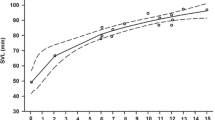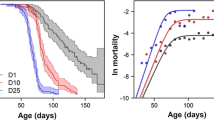Summary
Population characteristics of the desert isopod H. reaumuri and its energy allocation during each penophase were investigated in the Negev desert, Israel.
It was found that on the individual level, 52% of the energy is allocated to the prereproductive, and 48% to the reproductive phenophases. On the population level, only 10–23% is devoted to isopods which are involved in reproduction. Assuming that the energy allocation pattern in H. reaumuri is the consequence of its life history strategy, two unique evolutionary lines were suggested. One suggestion is the evolution of the family mode of life which increases the probability of the individual's survival. This is due to parental investment and co-operation between siblings. The other suggestion is the evolution of high energy utilization for burrowing, in order to solve the low and unpredictable nature of water resources in the desert.
Similar content being viewed by others
References
Calow, P.: The relationship between fecundity, phenology, and longevity: a system approach. Am. Nat. 107, 559–574 (1973)
Danin, A.: A Phytosociological-Ecological Study on the Northern Negev of Israel. Unpublished Ph.D., Jerusalem Hebrew University (1970)
Edney, E.B.: Transition from water to land in Isopod crustaceans. Am. Zool. 8, 309–326 (1968)
Evenari, M., Shannan, L., Tadmor, N.: The Negev — The Challenge of a Desert. Harvard University Press (1971)
Giesel, J.T.: Reproductive strategies as adaptations to life in temporally heterogeneous environment. Ann. Rev. Ecol. Syst. 7, 57–79 (1976)
Hatchett, S.P.: Biology of the Isopoda of Michigan. Ecol. Monogr. 17, 47–49 (1947)
Heeley, W.: Observation on the life histories of some terrestrial isopods. Proc. Zool. Soc. Land. B. 3, 79–149 (1941)
Linsemair, K.E.: The importance of family-specific “badges” for the cohesion of families in the social desert woodlouse, Hemilepistus reaumuri. Z. Tierpsychol. 31, 131–162 (1972)
Newell, R.C., Wieser, W., Pye, V.I.: Factor affecting oxygen consumption in the woodlouse Porcellio scaber Latr. Oecologia (Berl.) 16, 31–51 (1974)
Pandian, T.J.: Egg incubation and yolk utilization in the isopod Ligia oceanica. Proc. Indian Natl. Sci. Acad. 38, 430–441 (1968)
Paris, O.H., Pitelka, F.A.: Population characteristics of terrestrial isopod Armadillidium vulgare in california grass land. Ecology 43, 229–248 (1962)
Pianka, E.R.: On “r” and “k” selection. Am. Nat. 104, 592–597 (1970)
Randolph, P.A., Randolph, J.C., Mattingly, K., Foster, M.M.: Energy costs of reproduction in the cotton rat, Sigmodon hispidus. Ecology 58, 31–45 (1977)
Saito, S.: Structure and energetics of the population of Ligidium japonicum (Isopoda) in a warm temperature forest ecosystem. Jap. J. Ecol. 15, 47–55 (1965)
Saito, S.: Energetics of Isopoda populations in a forest of central Japan. Res. Popul. Ecol. 11, 229–258 (1969)
Schneider, P.: Contribution to the biology of the Afghan desert woodlouse Hemilepistus aphganicus Boratzky 1958 (Isopoda, Onisroidea) activity schedule. Zool. Auz., 195, 155–170 (1975)
Schneider, P., Jacobs, B.: Investigations on the intra and interspecific behavior of terrestrial isopods (Crustacea, Oniscoidea). Zool. Anz., 199, 173–186 (1977)
Scholander, P.F., Claff, C.L., Andrews, J.R., Wallach, D.F.: Micro-volumetric respirometry. J. Gen. Physiol. 35, 379–395 (1952)
Shachak, M., Chapman, E.A., Steinberger, Y.: Feeding, energy flow and soil turnover in the desert isopod, Hemilepistus reaumuri. Oecologia (Berl.) 24, 57–69 (1976)
Shachak, M., Steinberger, Y., Orr, Y.: Phenology, activity and regulation of radiation load in the desert isopod Hemilepistus reaumuri. Oecologia (Berl.) 40, 133–140 (1979)
Standen, V.: The life cycle and annual production of Trichoniscus pusillus pusillus (Crustacea: Isopoda) in a cheshire wood. Pedobiologia, 13, 273–291 (1973)
Sunderland, K.D., Hassall, M., Sutton, S.L.: The population dynamics of Philoscia muscorum (Crustecea, Oniscoidea) in a dune grassland ecosystem. J. Anim. Ecol. 45, 487–506 (1976)
Sutton, S.L.: The population dynamics of Trichonisus pusillus and Philoscia muscorum (Crustacea, Oniscoidea) in limestone grassland. J. Anim. Ecol. 37, 425–444 (1968)
Vandel, A.: Essai sur l'origine, l'evolution et al calssification des Oniscopidea (Isopodes, terrestres). Bull. Biol. France Belgique Suppl. 30, 1–143 (1943)
Author information
Authors and Affiliations
Rights and permissions
About this article
Cite this article
Shachak, M. Energy allocation and life history strategy of the desert isopod H. reaumuri . Oecologia 45, 404–413 (1980). https://doi.org/10.1007/BF00540214
Received:
Issue Date:
DOI: https://doi.org/10.1007/BF00540214




